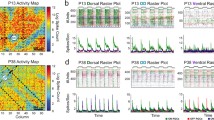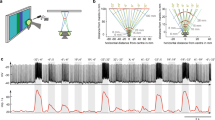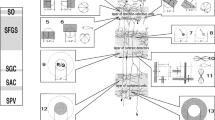Summary
-
1.
Positive potentials with the waveform of a smoothed retinula receptor potential are recorded from dragonfly lamina. All potentials of this type are calledlamina positive potentials, unless their origin is certain. To establish their origin and to see how information is processed in the lamina their sensitivity characteristics are examined in detail and compared with retinula cell somata.
-
2.
By comparing response noise at low intensities (discrete potentials), polarised light sensitivity, angular sensitivity, spectral sensitivity (Fig. 1) and intensity/ response functions it becomes clear that not all lamina positive potentials originate from retinula cell axons. The potentials are divided into two groups,axon responses andlamina depolarisationa.
-
3.
Axon responses have sensitivities and characteristics that resemble closely retinula cell somata (Fig. 2, 3, 5). In some cases recordings are correlated with a definite resting potential. It is concluded that axon responses probably originate intracellularly from retinula axons in the lamina. Some axon responses show small light induced action potentials (Fig. 6).
-
4.
Lamina depolarisations show the properties of a summed response from several retinula cell somata, i.e. high signal:noise ratio at low intensities, no polarised light sensitivity (Fig. 1), broad or distorted spectral sensitivities (Fig. 4). On the basis of this evidence, together with their broader angular sensitivity functions and unique intensity/response functions (Figs. 2, 3) it is proposed that lamina depolarisations are extracellular in origin.
-
5.
Previous studies also suggest an extracellular origin for the lamina depolarisation. It is concluded that this extracellular signal may act as a negative feed-back within the lamina.
-
6.
No pre-synaptic summation of retinula axon signals can be found in dragonfly lamina. Voltage amplification and improved signal: noise ratio result from a summation of inputs upon second order neurons. The unique individual properties of retinula cells are maintained in the lamina and they may function as inputs to other systems.
Similar content being viewed by others
References
Arnett, D. W.: Spatial and temporal integration properties of units in the first optic ganglion of Dipterans. J. Neurophysiol.35, 429–444 (1972)
Autrum, H., Kolb, G.: Spektrale Empfindlichkeit einzelner Sehzellen der Aeschniden. Z. vergl. Physiol.60, 450–477 (1968)
Autrum, H., Zettler, F., Järvilehto, M.: Postsynaptic potentials from a single monopolar neuron in the ganglion opticum I of the blowflyCalliphora. Z. vergl. Physiol.70, 414–424 (1970)
Autrum, H., Zwehl, V. von: Die spektrale Empfindlichkeit einzelner Sehzellen des Bienenauges. Z. vergl. Physiol.48, 357–384 (1964)
Behrens, M. E., Wulff, V. J.: Light-initiated responses of retinula and eccentric cells in theLimulus lateral eye. J. gen. Physiol.48, 1081–1093 (1965)
Boschek, C. B.: On the fine structure of the peripheral retina and lamina ganglionaris of the fly,Musca domestica. Z. Zellforsch.118, 369–409 (1971)
Bruckmoser, P.: Die spektrale Empfindlichkeit einzelner Sehzellen des RückenschwimmersNotonecta glauca L. (Heteroptera). Z. vergl. Physiol.59, 187–204 (1968)
Burkhardt, D.: Spectral sensitivity and other response characteristics of single visual cells in the arthropod eye. Symp. Soc. exp. Biol.16, 86–109 (1962)
Fulpius, B., Baumann, F.: Effects of sodium, potassium and calcium ions on slow and spike potentials in single photoreceptor cells. J. gen. Physiol.53, 541–561 (1969)
Furukawa, T., Furshpan, E. J.: Two inhibitory mechanisms in the Mauthner neurons of goldfish. J. Neurophysiol.26, 140–176 (1963)
Gemperlein, R., Smola, U.: Übertragungseigenschaften der Sehzelle der Schmeiss- fliegeCattiphora erythrocephala. 3. Verbesserung des Signal-Störunge-Verhältnisses durch präsynaptische Summation in der Lamina ganglionaris. J. comp. Physiol.79, 393–410 (1972)
Heisenberg, M.: Separation of receptor and lamina potentials in the electroretinogram of normal and mutantDrosophila. J. exp. Biol.55, 85–100 (1971)
Horridge, G. A.: Unit studies on the retina of dragonflies. Z. vergl. Physiol.62, 1–37 (1969)
Horridge, G. A., Meinertzhagen, I. A.: The exact neural projection of the visual fields upon the first and second ganglia of the insect eye. Z. vergl. Physiol.66, 369–378 (1970)
Ioannides, A. C.: Light adaptation and signal transmission in the compound eye of the giant water bugLethocerus (Belastomatidae: Hemiptera). Ph. D. Thesis, Australian National University 1972
Ioannides, A. C., Walcott, B.: Graded illumination potentials from retinula cell axons in the bugLethocerus. Z. vergl. Physiol.71, 315–325 (1971)
Järvilehto, M., Zettler, F.: Micro-localisation of lamina located visual cell activities in the compound eye of the blowflyCalliphora. Z. vergl. Physiol.69, 134–138 (1970)
Kirschfeld, K.: Discrete and graded potentials in the compound eye of the flyMusca. In: The functional organisation of the compound eye, C. G. Bernhard, ed., pp. 291–307. Oxford: Pergamon Press 1966
Langer, H., Thoreil, B.: Microspectrophotometry assay of visual pigments in single rhabdomeres of the insect eye. In: The functional organisation of the compound eye, C. G. Bernhard, ed. Oxford: Pergamon Press 1966
Laughlin, S. B.: Neural integration in the first optic neuropile of dragonflies. I. Signal amplification in dark-adapted second order neurons. J. comp. Physiol.84, 335–355 (1973)
Laughlin, S. B.: The function of the lamina ganglionaris. In: The compound eye and vision of insects, G. A. Horridge, ed. Oxford: University Press 1974a
Laughlin, S. B., Horridge, G. A.: Angular sensitivity of the retinula cells of dark- adapted worker bee. Z. vergl. Physiol.74, 329–335 (1971)
Leutscher-Hazelhoff, J. T., Kuiper, J. W.: Responses of the blowfly (Calliphora erythrocephala) to light flashes and to sinusoidal modulated light. Docum. opthal. (Den Haag)18, 275–283 (1964)
McCann, G. D., Arnett, D. W.: Spectral and polarisation sensitivity of the Dipteran visual system. J. gen. Physiol.59, 534–558 (1972)
Mote, M. I.: Focal recording of responses evoked by light in the lamina ganglionaris of the flySarcophaga bullata. J. exp. Zool.175, 149–158 (1970a)
Mote, M. I.: Electrical correlates of neural superposition in the eye of the flySarcophaga bullata. J. exp. Zool.175, 159–168 (1970b)
Rehbronn, W.: Gleichzeitige intracelluläre Doppelableitungen aus dem Komplexauge vonCalliphora erythrocephala. Z. vergl. Physiol.76, 285–301 (1972)
Scholes, J. H.: The electrical responses of the retinal receptors and the lamina in the visual system of the flyMusca. Kybernetik6, 149–162 (1969)
Shaw, S. R.: Organisation of the locust retina. Symp. zool. soc. Lond.23, 135–163 (1968)
Shaw, S. R.: Interreceptor coupling in the ommatidia of the drone honeybee and locust compound eyes. Vision Res.9, 999–1030 (1969)
Smola, U., Gemperlein, R.: Übertragungseigensohaften der Sehzelle der Schmeiss- fliegeCalliphora erythrocephala. 2. Die Abhängigkeit vom Ableitort: Retina- Lamina ganglionaris. Z. vergl. Physiol.79, 363–392 (1972)
Snyder, A.W., Menzel, R., Laughlin, S. B.: Structure and function of the fused rhabdom. J. comp. Physiol.87, 99–135 (1973)
Trujillo-Cenóz, O.: Some aspects of the structural organisation of the intermediate retina of Dipterans. J. Ultrastruct. Res.13, 1–33 (1965)
Trujillo-Cenóz, O., Melamed, J.: Compound eye of Dipterans: anatomical basis for integration—an electron microscope study. J. Ultrastruct. Res.16, 395–398 (1966)
Washizu, Y.: Electrical activity of single retinula cells in the compound eye of the blowflyCalliphora erythrocephala Meig. comp. Biochem. Physiol.12, 369–387 (1964)
Zettler, F., Järvilehto, M.: Active and passive axonal propagation of nonspike signals in the retina ofCalliphora. J. comp. Physiol.85, 89–104 (1973)
Author information
Authors and Affiliations
Rights and permissions
About this article
Cite this article
Laughlin, S.B. Neural integration in the first optic neuropile of dragonflies. J. Comp. Physiol. 92, 357–375 (1974). https://doi.org/10.1007/BF00694707
Received:
Issue Date:
DOI: https://doi.org/10.1007/BF00694707




